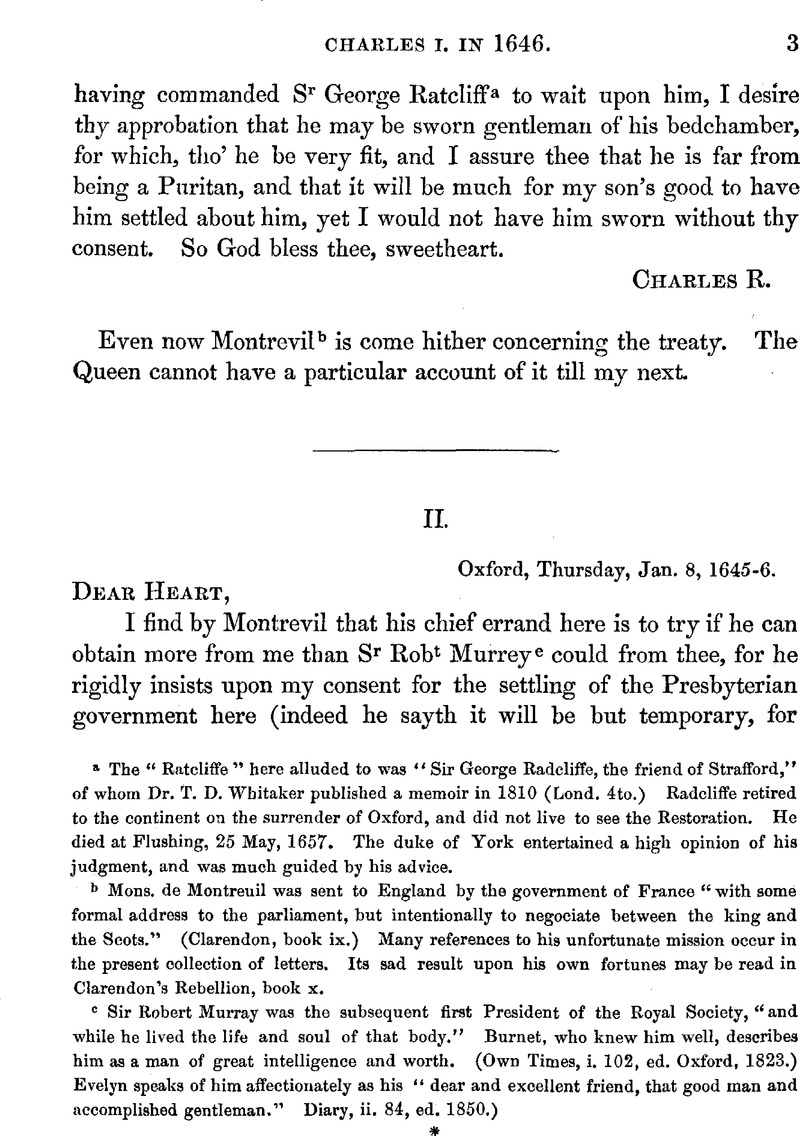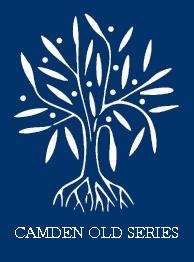No CrossRef data available.
Article contents
Letters from King Charles I. to Queen Henrietta Maria. II
Published online by Cambridge University Press: 23 February 2010
Abstract

- Type
- Charles I. in 1646
- Information
- Camden Old Series , Volume 63: Charles I. in 1646. Letters of King Charles the First to Queen Henrietta Maria , April 1856 , pp. 3 - 6
- Copyright
- Copyright © Royal Historical Society 1856
References
page 3 note a The “Ratcliffe”here alluded to was “Sir George Radeliffe, the friend of Stafford,” of whom Dr. T. D. Whitaker published a memoir in 1810 (Lond. 4to.) Radeliffe retired to the continent on the surrender of Oxford, and did not live to see the Restoration. He died at Flushing, 25 May, 1657. The duke of York entertained a high opinion of his judgment, and was much guided by his advice.
page 3 note b Mons. de Montreuil was sent to England by the government of France “with some formal address to the parliament, but intentionally to negociate between the king and the Scots.” (Clarendon, book ix.) Many references to his unfortunate mission occur in the present collection of letters. Its sad result upon his own fortunes may be read in Clarendon's Rebellion, book x.
page 3 note c Sir Robert Murray was the subsequent first President of the Royal Society, “and while he lived the life and soul of that body.” Burnet, who knew him well, describes him as a man of great intelligence and worth. (Own Times, i. 102, ed. Oxford, 1823.) Evelyn speaks of him affectionately as his “dear and excellent friend, that good man and accomplished gentleman.” Diary, ii. 84, ed. 1850.)
page 4 note a To “go no less,” in the sense of to “insist upon no less,” is a phrase which occurs in several parts of king Charles's correspondence. It will be found in the subsequent Letter, No. xxxiv. and also in the Clarendon State Papers.
page 4 note b The treaty to which this letter alludes was begun by a letter from the king to the speaker of the House of Lords, dated Oxford, 5 December, 1645. In that document Charles proposed to send the duke of Richmond and other gentlemen to Westminster, with “such propositions as his majesty is confident will be the foundation of a happy and well-grounded peace.” Not receiving an immediate answer, the king by other letters, dated the 15th and 20th of December, 1645, proposed that upon a guarantee for his personal safety he would proceed to Westminster to have a personal treaty with the parliament. In the meantime the parliament, in answer to the king's first and second letters, had declined to receive the king's suggested ambassadors. The king replied, on the 29th Dec. by again urging his previous proposal of a personal treaty, and assuring the parliament that if it were consented to he doubted not “to give a just satisfaction, not only concerning the business of Ireland,” but also for the payment of the public debts to the Scots and the City of London, as he had already in his former message “shewn a fair way for the settling of the militia.” These royal messages are printed in king Charles's Works, pp. 104—106, ed. 1687.
page 4 note c Anne of Austria, queen regent during the minority of her son Louis XIV.
page 5 note a The “young prince of Orange” was Charles's son-in-law, William of Nassau, married in 1641 to the princess Mary, and father by her of the future William III. of England. He was elected a Knight of the Garter at Oxford on the 2nd of March, 1644—5. It has been stated that the George and Garter were sent to him on the 4th of the same month. (Beltz's Memorials of the Garter, p. clxxxix.)
page 5 note b The words within brackets look as if they have been introduced into the MS. at a later period, and by some other person than the original transcriber.
page 5 note c Montrose was at this time in arms for the king in Scotland.


